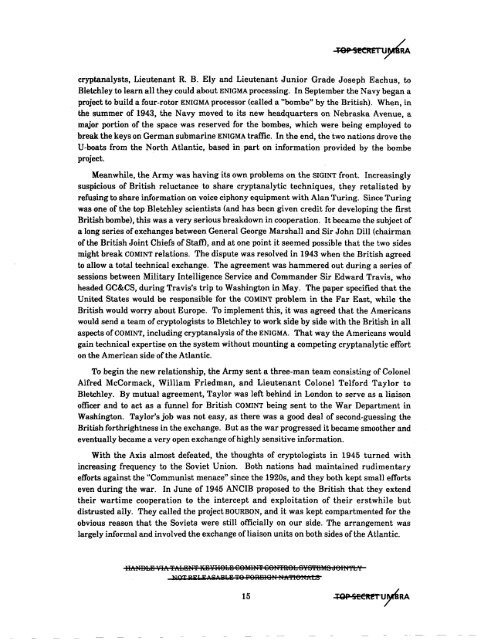American Cryptology during the Cold War - The Black Vault
American Cryptology during the Cold War - The Black Vault
American Cryptology during the Cold War - The Black Vault
You also want an ePaper? Increase the reach of your titles
YUMPU automatically turns print PDFs into web optimized ePapers that Google loves.
:rep Sl!eREru~<br />
cryptanalysts, Lieutenant R. B. Ely and Lieutenant Junior Grade Joseph Eachus, to<br />
Bletchley to learn all <strong>the</strong>y could about ENIGMA processing. In September <strong>the</strong> Navy began a<br />
project to build a four-rotor ENIGMA processor (called a "bombe" by <strong>the</strong> British). When, in<br />
<strong>the</strong> summer of 1943, <strong>the</strong> Navy moved to its new headquarters on Nebraska Avenue, a<br />
major portion of <strong>the</strong> space was reserved for <strong>the</strong> bombes, which were being employed to<br />
break <strong>the</strong> keys on German submarine ENIGMA traffic. In <strong>the</strong> end, <strong>the</strong> two nations drove <strong>the</strong><br />
U-boats from <strong>the</strong> North Atlantic, based in part on information provided by <strong>the</strong> bombe<br />
project.<br />
Meanwhile, <strong>the</strong> Army was having its own problems on <strong>the</strong> SIGINT front. Increasingly<br />
suspicious of British reluctance to share cryptanalytic techniques, <strong>the</strong>y retaliated by<br />
refusing to share informationon voice ciphony equipment with Alan Turing. Since Turing<br />
was one of <strong>the</strong> top Bletchley scientists (and has been given credit for developing <strong>the</strong> first<br />
Britishbombe), this was a very serious breakdown in cooperation. It became <strong>the</strong> subject of<br />
a long series ofexchanges between General George Marshall and Sir John Dill (chairman<br />
of<strong>the</strong> British Joint Chiefs ofStaff), and at one point it seemed possible that <strong>the</strong> two sides<br />
might break COMINT relations. <strong>The</strong> dispute was resolved in 1943 when <strong>the</strong> British agreed<br />
to allow a total technical exchange. <strong>The</strong> agreement was hammered out <strong>during</strong> a series of<br />
sessions between Military Intelligence Service and Commander Sir Edward Travis, who<br />
headed GC&CS, <strong>during</strong> Travis's trip to Washington in May. <strong>The</strong> paper specified that <strong>the</strong><br />
United States would be responsible for <strong>the</strong> COMINT problem in <strong>the</strong> Far East, while <strong>the</strong><br />
British would worry about Europe. To implement this, it was agreed that <strong>the</strong> <strong>American</strong>s<br />
would send a team of cryptologists to Bletchley to work side by side with <strong>the</strong> British in all<br />
aspects ofCOMINT, including cryptanalysis of<strong>the</strong> ENIGMA. That way <strong>the</strong> <strong>American</strong>s would<br />
gain technical expertise on <strong>the</strong> system without mounting a competing cryptanalytic effort<br />
on <strong>the</strong> <strong>American</strong> side of<strong>the</strong> Atlantic.<br />
To begin <strong>the</strong> new relationship, <strong>the</strong> Army sent a three-man team consisting of Colonel<br />
Alfred McCormack, William Friedman, and Lieutenant Colonel Telford Taylor to<br />
Bletchley. By mutual agreement, Taylor was left behind in London to serve as a liaison<br />
officer and to act as a funnel for British COMINT being sent to <strong>the</strong> <strong>War</strong> Department in<br />
Washington. Taylor's job was not easy, as <strong>the</strong>re was a good deal of second-guessing <strong>the</strong><br />
British forthrightness in <strong>the</strong> exchange. But as <strong>the</strong> war progressed it became smoo<strong>the</strong>r and<br />
eventually became a very open exchange ofhighly sensitive information.<br />
With <strong>the</strong> Axis almost defeated, <strong>the</strong> thoughts of cryptologists in 1945 turned with<br />
increasing frequency to <strong>the</strong> Soviet Union. Both nations had maintained rudimentary<br />
efforts against <strong>the</strong> "Communist menace" since <strong>the</strong> 1920s, and <strong>the</strong>y both kept small efforts<br />
even <strong>during</strong> <strong>the</strong> war. In June of 1945 ANCIB proposed to <strong>the</strong> British that <strong>the</strong>y extend<br />
<strong>the</strong>ir wartime cooperation to <strong>the</strong> intercept and exploitation of <strong>the</strong>ir erstwhile but<br />
distrusted ally. <strong>The</strong>y called <strong>the</strong> project BOURBON, and it was kept compartmented for <strong>the</strong><br />
obvious reason that <strong>the</strong> Soviets were still officially on our side. <strong>The</strong> arrangement was<br />
largely informal and involved <strong>the</strong> exchange ofliaison units on both sides of<strong>the</strong> Atlantic.<br />
nA~fBY!lVIA 'fll:hB~f'fKBYII8hB 08MUf'f 08U'fR8b 8¥S'fi!JMS d6IH'i'bY<br />
1'1O?' PIi:J,,1i: A i A RYJ TQ FQREll8n n1r'i'16Ib\L~<br />
15
















